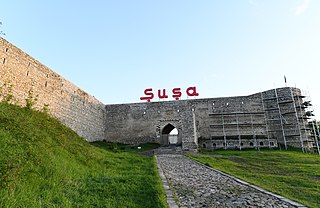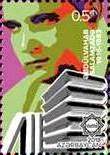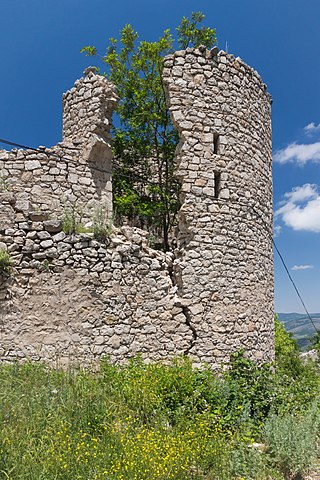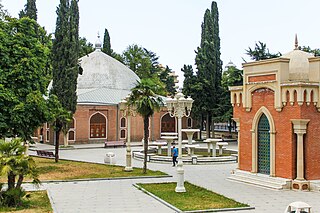
Shaki is a city in northwestern Azerbaijan, surrounded by the district of the same name. It is located in the southern part of the Greater Caucasus mountain range, 240 km (150 mi) from Baku. As of 2020, it has a population of 68,400. The center of the city and the Palace of Shaki Khans were inscribed in the UNESCO World Heritage List in 2019 because of their unique architecture and history as an important trading center along the Silk Road.

Yukhari Govhar Agha Mosque (Azerbaijani: Yuxarı Gövhər Ağa məscidi, is a mosque located in the city of Shusha, Azerbaijan. The mosque also bears the name Boyuk Juma of Govhar Agha.

Caravanserai of Agha Gahraman Mirsiyab Oghlu(Azerbaijani: Ağa Qəhrəman Mirsiyab oğlunun karvansarası) also known as the Masjidli Caravanserai, is located at 31 M.F. Akhundov Street in the city of Shusha. The caravanserai has been registered as an important historical and cultural monument of the country by the Ministry of Culture and Tourism of the Republic of Azerbaijan.

The Shusha fortress or Shushi fortress is a fortress surrounding the historical centre of Shusha, also called Shushi. The newly conquered castle town was called "Panahabad fortress" named after Panah Ali Khan who together with Melik Shahnazar was the founder of the fort. In later years, the city was just called "Fortress". A settlement at Shusha is first recorded in a 15th-century illustrated Armenian gospel which mentions the "Shushu village".

Soviets Square or Sovetov Square is a city square of Rostov-on-Don, situated in Kirovskiy District at the intersection of Bolshaya Sadovaya Street, Voroshilovsky Avenue, Sokolova Avenue and Sotsialisticheskaya Street.

Ibrahim Khalil Khan palace or Ibrahim Khalil Khan castle is a historical palace located in the south-eastern part of Shusha, near Dashalty village. In some sources, the palace is also called palace of Karabakh Khans.
History of Barda includes the history of the Azerbaijani city of Barda from the medieval period to the present day.

The House of Khurshidbanu Natavan, also known as the Palace of Natavan, Daughter of the Khan, is an 18th or 19th-century historical and architectural monument, and a museum in Shusha, Azerbaijan.

Abdul Vahab Rahim oglu Salamzadeh, was a Soviet-Azerbaijani art critic, architect, doctor of art history, and academician. He had served as the deputy director of the Institute of Architecture and Art of the Academy of Sciences of the Azerbaijani SSR, and head of the department of history and theory of architecture in the same institute, and received the title of Honoured Builder of the Azerbaijan SSR.

Pir Hasan Mausoleum is a historical and religious architectural monument of the XVII century located in Mardakan, Azerbaijan.
Kalazeyva Mausoleum is a historical and architectural monument located in Kalazeyva village of Ismayilli District. Due to the location of an ancient cemetery and shrine in the village of Kalazeyva, the inhabitants of the surrounding areas also used here for burial.

Hazra Mausoleum Complex is a complex of historical and architectural monuments built in XV-XVI centuries located in Hazra village of Qabala District.
Ashaghy Meydan or Torpag Meydany is one of the oldest squares in the city of Shusha being located in the lower part of the Shusha fortress.

Gara Boyuk Khanim Castle is an 18th century palace-castle located on a hill in the southeastern part of the town of Shusha (Shushi) in the Karabakh region of Azerbaijan. It is composed of four towers in a square plan. It is one of the two castles of Shusha that have survived to present day.

Safi bey’s house is a historical and architectural monument of the 18th century being located in Shusha.
Mammad Hasan agha palace is a historical palace located in the historical center of Shusha city. The palace was built on a steep rock in the southeast of the Shusha plateau. The palace belonged to Mammad Hasan agha, the eldest son of Ibrahim Khalil Khan, and his family members. Agha Mohammad Shah Qajar Muhammad Hasan, who captured Shusha in 1796, began to live in the Mammad Hasan agha palace, and in 1797 he was murdered in this palace by his servant Safar Ali.
House of Haji Amir is a historical-architectural monument built by the merchant Haji Amir in the middle of the 18th century, located in the Tabrizli neighbourhood of Shusha city.

Divankhana Square or Bazaar-bashi is the first and the largest city square located at the entrance to Shusha, Azerbaijan from the side of the Ganja Gate. The largest shopping street Rasta Bazaar starts from this area.

Shah Abbas Square is a square located in the historical center of the city of Ganja, Azerbaijan. At one time, it was the main memorial complex of the suburb of the Ganja fortress. The complex of Shah Abbas Square was firstly mentioned in the plan of the Ganja fortress of 1797. This architectural ensemble, located in the center of the suburb, consisted of a mosque, a bathhouse and other buildings.

Mashadi Mirza Gafar Ismayilov was a notable Azerbaijani architect of the late 19th century, credited with the construction of over a hundred single and two-story residential buildings, numerous shops, a mosque, and a bathhouse.

















